diff options
Diffstat (limited to 'docs/guides/monitor/process.md')
| -rw-r--r-- | docs/guides/monitor/process.md | 231 |
1 files changed, 121 insertions, 110 deletions
diff --git a/docs/guides/monitor/process.md b/docs/guides/monitor/process.md index 2f46d7abc..7cc327a01 100644 --- a/docs/guides/monitor/process.md +++ b/docs/guides/monitor/process.md @@ -23,38 +23,46 @@ SQL queries or know a bunch of arbitrary command-line flags. With Netdata's process monitoring, you can: -- Benchmark/optimize performance of standard applications, like web servers or databases -- Benchmark/optimize performance of custom applications -- Troubleshoot CPU/memory/disk utilization issues (why is my system's CPU spiking right now?) -- Perform granular capacity planning based on the specific needs of your infrastructure -- Search for leaking file descriptors -- Investigate zombie processes +- Benchmark/optimize performance of standard applications, like web servers or databases +- Benchmark/optimize performance of custom applications +- Troubleshoot CPU/memory/disk utilization issues (why is my system's CPU spiking right now?) +- Perform granular capacity planning based on the specific needs of your infrastructure +- Search for leaking file descriptors +- Investigate zombie processes ... and much more. Let's get started. ## Prerequisites -- One or more Linux nodes running [Netdata](/docs/get-started.mdx). If you need more time to understand Netdata before - following this guide, see the [infrastructure](/docs/quickstart/infrastructure.md) or - [single-node](/docs/quickstart/single-node.md) monitoring quickstarts. -- A general understanding of how to [configure the Netdata Agent](/docs/configure/nodes.md) using `edit-config`. -- A Netdata Cloud account. [Sign up](https://app.netdata.cloud) if you don't have one already. +- One or more Linux nodes running [Netdata](https://github.com/netdata/netdata/blob/master/docs/get-started.mdx). If you + need more time to understand Netdata before + following this guide, see + the [infrastructure](https://github.com/netdata/netdata/blob/master/docs/quickstart/infrastructure.md) or + [single-node](https://github.com/netdata/netdata/blob/master/docs/quickstart/single-node.md) monitoring quickstarts. +- A general understanding of how + to [configure the Netdata Agent](https://github.com/netdata/netdata/blob/master/docs/configure/nodes.md) + using `edit-config`. +- A Netdata Cloud account. [Sign up](https://app.netdata.cloud) if you don't have one already. ## How does Netdata do process monitoring? -The Netdata Agent already knows to look for hundreds of [standard applications that we support via -collectors](/collectors/COLLECTORS.md), and groups them based on their purpose. Let's say you want to monitor a MySQL +The Netdata Agent already knows to look for hundreds +of [standard applications that we support via collectors](https://github.com/netdata/netdata/blob/master/collectors/COLLECTORS.md), +and groups them based on their +purpose. Let's say you want to monitor a MySQL database using its process. The Netdata Agent already knows to look for processes with the string `mysqld` in their name, along with a few others, and puts them into the `sql` group. This `sql` group then becomes a dimension in all process-specific charts. The process and groups settings are used by two unique and powerful collectors. -[**`apps.plugin`**](/collectors/apps.plugin/README.md) looks at the Linux process tree every second, much like `top` or +[**`apps.plugin`**](https://github.com/netdata/netdata/blob/master/collectors/apps.plugin/README.md) looks at the Linux +process tree every second, much like `top` or `ps fax`, and collects resource utilization information on every running process. It then automatically adds a layer of meaningful visualization on top of these metrics, and creates per-process/application charts. -[**`ebpf.plugin`**](/collectors/ebpf.plugin/README.md): Netdata's extended Berkeley Packet Filter (eBPF) collector +[**`ebpf.plugin`**](https://github.com/netdata/netdata/blob/master/collectors/ebpf.plugin/README.md): Netdata's extended +Berkeley Packet Filter (eBPF) collector monitors Linux kernel-level metrics for file descriptors, virtual filesystem IO, and process management, and then hands process-specific metrics over to `apps.plugin` for visualization. The eBPF collector also collects and visualizes metrics on an _event frequency_, which means it captures every kernel interaction, and not just the volume of @@ -65,55 +73,55 @@ interaction at every second in time. That's even more precise than Netdata's sta With these collectors working in parallel, Netdata visualizes the following per-second metrics for _any_ process on your Linux systems: -- CPU utilization (`apps.cpu`) - - Total CPU usage - - User/system CPU usage (`apps.cpu_user`/`apps.cpu_system`) -- Disk I/O - - Physical reads/writes (`apps.preads`/`apps.pwrites`) - - Logical reads/writes (`apps.lreads`/`apps.lwrites`) - - Open unique files (if a file is found open multiple times, it is counted just once, `apps.files`) -- Memory - - Real Memory Used (non-shared, `apps.mem`) - - Virtual Memory Allocated (`apps.vmem`) - - Minor page faults (i.e. memory activity, `apps.minor_faults`) -- Processes - - Threads running (`apps.threads`) - - Processes running (`apps.processes`) - - Carried over uptime (since the last Netdata Agent restart, `apps.uptime`) - - Minimum uptime (`apps.uptime_min`) - - Average uptime (`apps.uptime_average`) - - Maximum uptime (`apps.uptime_max`) - - Pipes open (`apps.pipes`) -- Swap memory - - Swap memory used (`apps.swap`) - - Major page faults (i.e. swap activity, `apps.major_faults`) -- Network - - Sockets open (`apps.sockets`) -- eBPF file - - Number of calls to open files. (`apps.file_open`) - - Number of files closed. (`apps.file_closed`) - - Number of calls to open files that returned errors. - - Number of calls to close files that returned errors. -- eBPF syscall - - Number of calls to delete files. (`apps.file_deleted`) - - Number of calls to `vfs_write`. (`apps.vfs_write_call`) - - Number of calls to `vfs_read`. (`apps.vfs_read_call`) - - Number of bytes written with `vfs_write`. (`apps.vfs_write_bytes`) - - Number of bytes read with `vfs_read`. (`apps.vfs_read_bytes`) - - Number of calls to write a file that returned errors. - - Number of calls to read a file that returned errors. -- eBPF process - - Number of process created with `do_fork`. (`apps.process_create`) - - Number of threads created with `do_fork` or `__x86_64_sys_clone`, depending on your system's kernel version. (`apps.thread_create`) - - Number of times that a process called `do_exit`. (`apps.task_close`) -- eBPF net - - Number of bytes sent. (`apps.bandwidth_sent`) - - Number of bytes received. (`apps.bandwidth_recv`) +- CPU utilization (`apps.cpu`) + - Total CPU usage + - User/system CPU usage (`apps.cpu_user`/`apps.cpu_system`) +- Disk I/O + - Physical reads/writes (`apps.preads`/`apps.pwrites`) + - Logical reads/writes (`apps.lreads`/`apps.lwrites`) + - Open unique files (if a file is found open multiple times, it is counted just once, `apps.files`) +- Memory + - Real Memory Used (non-shared, `apps.mem`) + - Virtual Memory Allocated (`apps.vmem`) + - Minor page faults (i.e. memory activity, `apps.minor_faults`) +- Processes + - Threads running (`apps.threads`) + - Processes running (`apps.processes`) + - Carried over uptime (since the last Netdata Agent restart, `apps.uptime`) + - Minimum uptime (`apps.uptime_min`) + - Average uptime (`apps.uptime_average`) + - Maximum uptime (`apps.uptime_max`) + - Pipes open (`apps.pipes`) +- Swap memory + - Swap memory used (`apps.swap`) + - Major page faults (i.e. swap activity, `apps.major_faults`) +- Network + - Sockets open (`apps.sockets`) +- eBPF file + - Number of calls to open files. (`apps.file_open`) + - Number of files closed. (`apps.file_closed`) + - Number of calls to open files that returned errors. + - Number of calls to close files that returned errors. +- eBPF syscall + - Number of calls to delete files. (`apps.file_deleted`) + - Number of calls to `vfs_write`. (`apps.vfs_write_call`) + - Number of calls to `vfs_read`. (`apps.vfs_read_call`) + - Number of bytes written with `vfs_write`. (`apps.vfs_write_bytes`) + - Number of bytes read with `vfs_read`. (`apps.vfs_read_bytes`) + - Number of calls to write a file that returned errors. + - Number of calls to read a file that returned errors. +- eBPF process + - Number of process created with `do_fork`. (`apps.process_create`) + - Number of threads created with `do_fork` or `__x86_64_sys_clone`, depending on your system's kernel + version. (`apps.thread_create`) + - Number of times that a process called `do_exit`. (`apps.task_close`) +- eBPF net + - Number of bytes sent. (`apps.bandwidth_sent`) + - Number of bytes received. (`apps.bandwidth_recv`) As an example, here's the per-process CPU utilization chart, including a `sql` group/dimension. -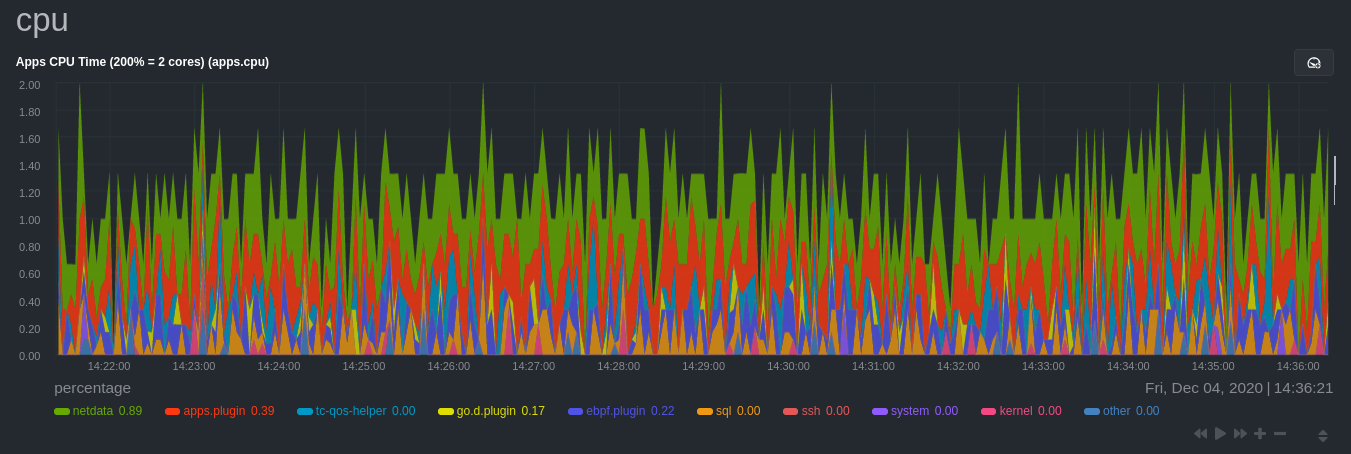 + ## Configure the Netdata Agent to recognize a specific process @@ -123,7 +131,8 @@ aware of hundreds of processes, and collects metrics from them automatically. But, if you want to change the grouping behavior, add an application that isn't yet supported in the Netdata Agent, or monitor a custom application, you need to edit the `apps_groups.conf` configuration file. -Navigate to your [Netdata config directory](/docs/configure/nodes.md) and use `edit-config` to edit the file. +Navigate to your [Netdata config directory](https://github.com/netdata/netdata/blob/master/docs/configure/nodes.md) and +use `edit-config` to edit the file. ```bash cd /etc/netdata # Replace this with your Netdata config directory if not at /etc/netdata. @@ -138,7 +147,8 @@ others, and groups them into `sql`. That makes sense, since all these processes sql: mysqld* mariad* postgres* postmaster* oracle_* ora_* sqlservr ``` -These groups are then reflected as [dimensions](/web/README.md#dimensions) within Netdata's charts. +These groups are then reflected as [dimensions](https://github.com/netdata/netdata/blob/master/web/README.md#dimensions) +within Netdata's charts. 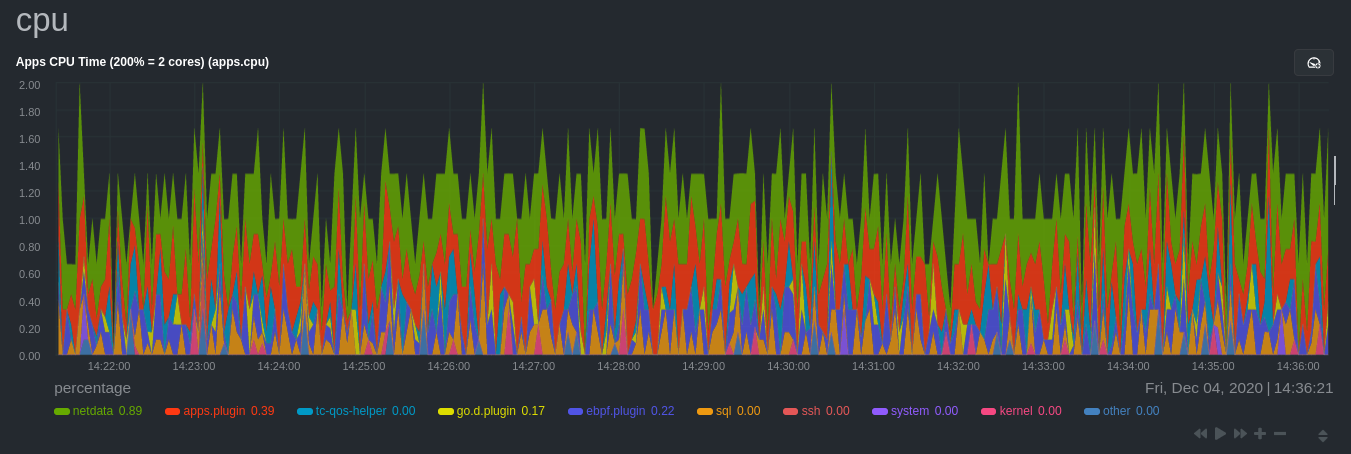 @@ -153,12 +163,13 @@ shouldn't need to configure it to discover them. However, if you're using multiple applications that the Netdata Agent groups together you may want to separate them for more precise monitoring. If you're not running any other types of SQL databases on that node, you don't need to change -the grouping, since you know that any MySQL is the only process contributing to the `sql` group. +the grouping, since you know that any MySQL is the only process contributing to the `sql` group. Let's say you're using both MySQL and PostgreSQL databases on a single node, and want to monitor their processes -independently. Open the `apps_groups.conf` file as explained in the [section -above](#configure-the-netdata-agent-to-recognize-a-specific-process) and scroll down until you find the `database -servers` section. Create new groups for MySQL and PostgreSQL, and move their process queries into the unique groups. +independently. Open the `apps_groups.conf` file as explained in +the [section above](#configure-the-netdata-agent-to-recognize-a-specific-process) and scroll down until you find +the `database servers` section. Create new groups for MySQL and PostgreSQL, and move their process queries into the +unique groups. ```conf # ----------------------------------------------------------------------------- @@ -169,17 +180,18 @@ postgres: postgres* sql: mariad* postmaster* oracle_* ora_* sqlservr ``` -Restart Netdata with `sudo systemctl restart netdata`, or the [appropriate -method](/docs/configure/start-stop-restart.md) for your system, to start collecting utilization metrics from your -application. Time to [visualize your process metrics](#visualize-process-metrics). +Restart Netdata with `sudo systemctl restart netdata`, or +the [appropriate method](https://github.com/netdata/netdata/blob/master/docs/configure/start-stop-restart.md) for your system, to start collecting utilization metrics +from your application. Time to [visualize your process metrics](#visualize-process-metrics). ### Custom applications Let's assume you have an application that runs on the process `custom-app`. To monitor eBPF metrics for that application separate from any others, you need to create a new group in `apps_groups.conf` and associate that process name with it. -Open the `apps_groups.conf` file as explained in the [section -above](#configure-the-netdata-agent-to-recognize-a-specific-process). Scroll down to `# NETDATA processes accounting`. +Open the `apps_groups.conf` file as explained in +the [section above](#configure-the-netdata-agent-to-recognize-a-specific-process). Scroll down +to `# NETDATA processes accounting`. Above that, paste in the following text, which creates a new `custom-app` group with the `custom-app` process. Replace `custom-app` with the name of your application's Linux process. `apps_groups.conf` should now look like this: @@ -195,26 +207,25 @@ custom-app: custom-app ... ``` -Restart Netdata with `sudo systemctl restart netdata`, or the [appropriate -method](/docs/configure/start-stop-restart.md) for your system, to start collecting utilization metrics from your -application. +Restart Netdata with `sudo systemctl restart netdata`, or +the [appropriate method](https://github.com/netdata/netdata/blob/master/docs/configure/start-stop-restart.md) for your system, to start collecting utilization metrics +from your application. ## Visualize process metrics Now that you're collecting metrics for your process, you'll want to visualize them using Netdata's real-time, -interactive charts. Find these visualizations in the same section regardless of whether you use [Netdata -Cloud](https://app.netdata.cloud) for infrastructure monitoring, or single-node monitoring with the local Agent's -dashboard at `http://localhost:19999`. +interactive charts. Find these visualizations in the same section regardless of whether you +use [Netdata Cloud](https://app.netdata.cloud) for infrastructure monitoring, or single-node monitoring with the local +Agent's dashboard at `http://localhost:19999`. -If you need a refresher on all the available per-process charts, see the [above -list](#per-process-metrics-and-charts-in-netdata). +If you need a refresher on all the available per-process charts, see +the [above list](#per-process-metrics-and-charts-in-netdata). ### Using Netdata's application collector (`apps.plugin`) `apps.plugin` puts all of its charts under the **Applications** section of any Netdata dashboard. -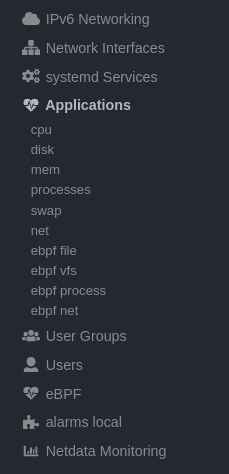 + Let's continue with the MySQL example. We can create a [test database](https://www.digitalocean.com/community/tutorials/how-to-measure-mysql-query-performance-with-mysqlslap) in @@ -223,11 +234,9 @@ MySQL to generate load on the `mysql` process. `apps.plugin` immediately collects and visualizes this activity `apps.cpu` chart, which shows an increase in CPU utilization from the `sql` group. There is a parallel increase in `apps.pwrites`, which visualizes writes to disk. -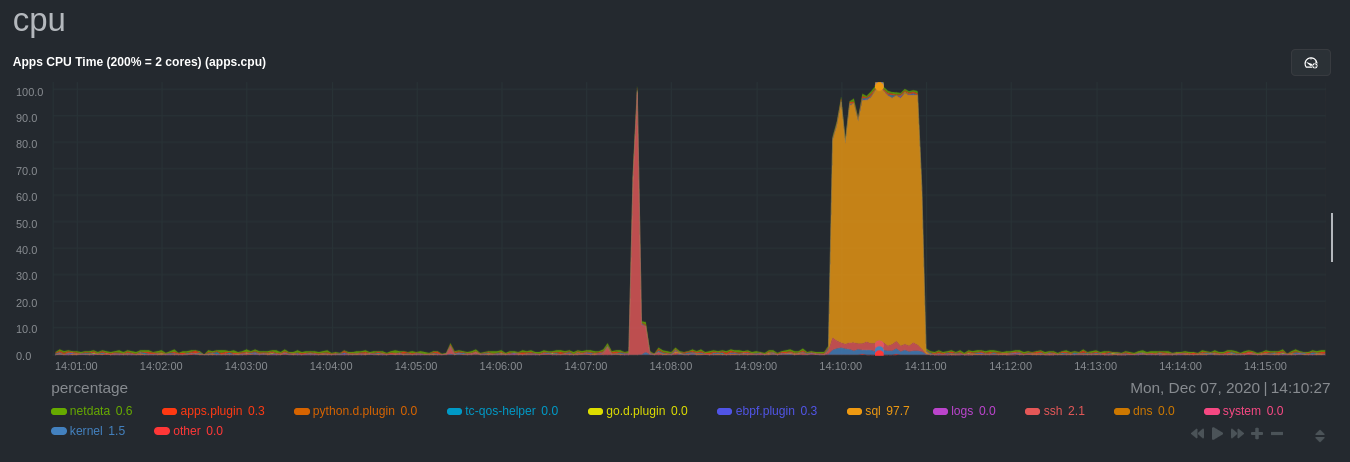 + -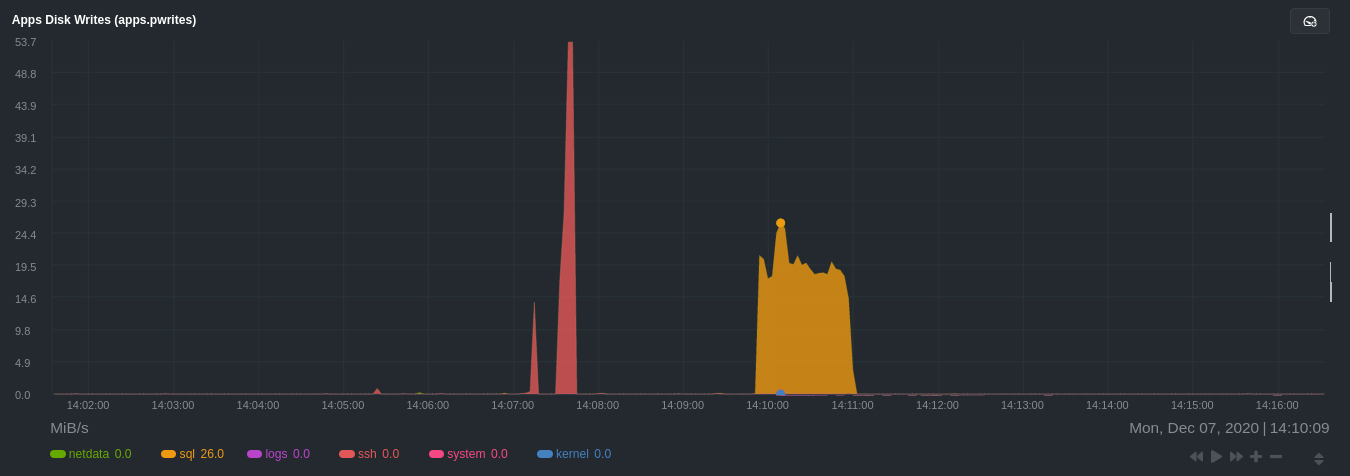 + Next, the `mysqlslap` utility queries the database to provide some benchmarking load on the MySQL database. It won't look exactly like a production database executing lots of user queries, but it gives you an idea into the possibility of @@ -240,8 +249,7 @@ sudo mysqlslap --user=sysadmin --password --host=localhost --concurrency=50 --i The following per-process disk utilization charts show spikes under the `sql` group at the same time `mysqlslap` was run numerous times, with slightly different concurrency and query options. -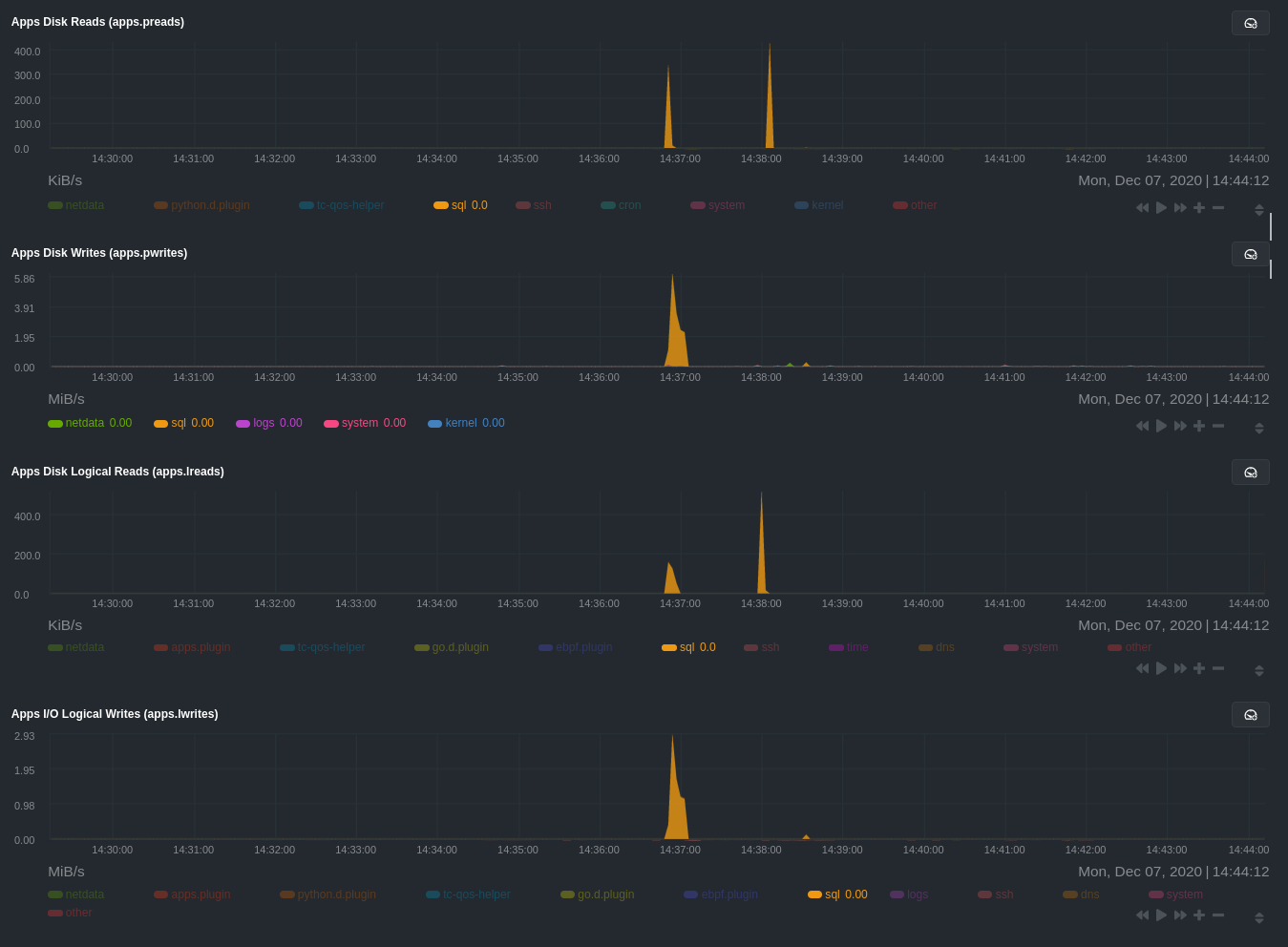 + > 💡 Click on any dimension below a chart in Netdata Cloud (or to the right of a chart on a local Agent dashboard), to > visualize only that dimension. This can be particularly useful in process monitoring to separate one process' @@ -256,8 +264,7 @@ For example, running the above workload shows the entire "story" how MySQL inter processes/threads to handle a large number of SQL queries, then subsequently close the tasks as each query returns the relevant data. -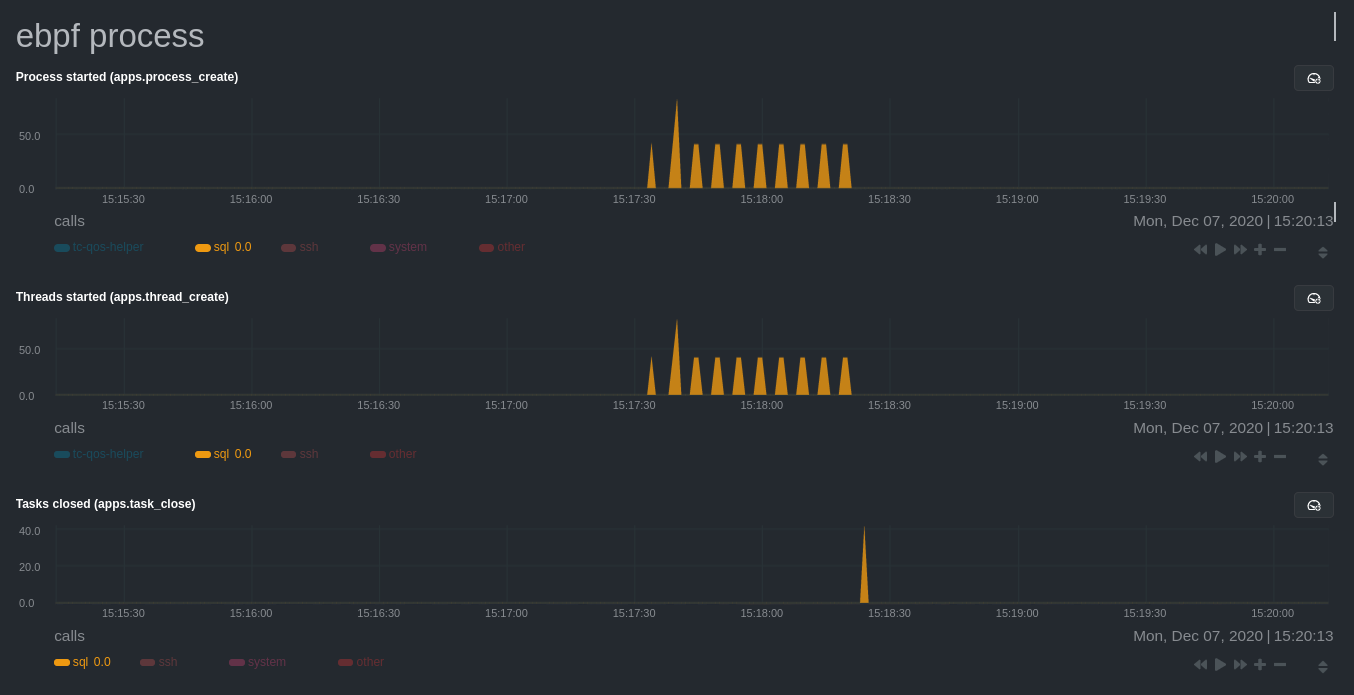 + `ebpf.plugin` visualizes additional eBPF metrics, which are system-wide and not per-process, under the **eBPF** section. @@ -267,35 +274,39 @@ Now that you have `apps_groups.conf` configured correctly, and know where to fin Netdata's ecosystem, you can precisely monitor the health and performance of any process on your node using per-second metrics. -For even more in-depth troubleshooting, see our guide on [monitoring and debugging applications with -eBPF](/docs/guides/troubleshoot/monitor-debug-applications-ebpf.md). +For even more in-depth troubleshooting, see our guide +on [monitoring and debugging applications with eBPF](https://github.com/netdata/netdata/blob/master/docs/guides/troubleshoot/monitor-debug-applications-ebpf.md). -If the process you're monitoring also has a [supported collector](/collectors/COLLECTORS.md), now is a great time to set +If the process you're monitoring also has +a [supported collector](https://github.com/netdata/netdata/blob/master/collectors/COLLECTORS.md), now is a great time to +set that up if it wasn't autodetected. With both process utilization and application-specific metrics, you should have every -piece of data needed to discover the root cause of an incident. See our [collector -setup](/docs/collect/enable-configure.md) doc for details. +piece of data needed to discover the root cause of an incident. See +our [collector setup](https://github.com/netdata/netdata/blob/master/docs/collect/enable-configure.md) doc for details. -[Create new dashboards](/docs/visualize/create-dashboards.md) in Netdata Cloud using charts from `apps.plugin`, +[Create new dashboards](https://github.com/netdata/netdata/blob/master/docs/visualize/create-dashboards.md) in Netdata +Cloud using charts from `apps.plugin`, `ebpf.plugin`, and application-specific collectors to build targeted dashboards for monitoring key processes across your infrastructure. -Try running [Metric Correlations](https://learn.netdata.cloud/docs/cloud/insights/metric-correlations) on a node that's -running the process(es) you're monitoring. Even if nothing is going wrong at the moment, Netdata Cloud's embedded -intelligence helps you better understand how a MySQL database, for example, might influence a system's volume of memory -page faults. And when an incident is afoot, use Metric Correlations to reduce mean time to resolution (MTTR) and -cognitive load. - -If you want more specific metrics from your custom application, check out Netdata's [statsd -support](/collectors/statsd.plugin/README.md). With statd, you can send detailed metrics from your application to -Netdata and visualize them with per-second granularity. Netdata's statsd collector works with dozens of [statsd server -implementations](https://github.com/etsy/statsd/wiki#client-implementations), which work with most application +Try +running [Metric Correlations](https://github.com/netdata/netdata/blob/master/docs/cloud/insights/metric-correlations.md) +on a node that's running the process(es) you're monitoring. Even if nothing is going wrong at the moment, Netdata +Cloud's embedded intelligence helps you better understand how a MySQL database, for example, might influence a system's +volume of memory page faults. And when an incident is afoot, use Metric Correlations to reduce mean time to resolution ( +MTTR) and cognitive load. + +If you want more specific metrics from your custom application, check out +Netdata's [statsd support](https://github.com/netdata/netdata/blob/master/collectors/statsd.plugin/README.md). With statd, you can send detailed metrics from your +application to Netdata and visualize them with per-second granularity. Netdata's statsd collector works with dozens of +[statsd server implementations](https://github.com/etsy/statsd/wiki#client-implementations), which work with most application frameworks. ### Related reference documentation -- [Netdata Agent · `apps.plugin`](/collectors/apps.plugin/README.md) -- [Netdata Agent · `ebpf.plugin`](/collectors/ebpf.plugin/README.md) -- [Netdata Agent · Dashboards](/web/README.md#dimensions) -- [Netdata Agent · MySQL collector](https://learn.netdata.cloud/docs/agent/collectors/go.d.plugin/modules/mysql) +- [Netdata Agent · `apps.plugin`](https://github.com/netdata/netdata/blob/master/collectors/apps.plugin/README.md) +- [Netdata Agent · `ebpf.plugin`](https://github.com/netdata/netdata/blob/master/collectors/ebpf.plugin/README.md) +- [Netdata Agent · Dashboards](https://github.com/netdata/netdata/blob/master/web/README.md#dimensions) +- [Netdata Agent · MySQL collector](https://github.com/netdata/go.d.plugin/blob/master/modules/mysql/README.md) |
